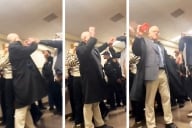You have /5 articles left.
Sign up for a free account or log in.

Steve Calcott | Flickr
In 2011, the Department of Education’s Office for Civil Rights issued a Dear Colleague letter that urged institutions to better investigate and adjudicate cases of campus sexual assault. The letter spelled out how the department interprets Title IX of the Education Amendments of 1972, and for the past five years it has been the guiding document for colleges hoping to avoid a federal civil rights investigation into how they handle complaints of sexual violence.
The department’s views were praised by victims and their advocates and led to many changes on college campuses, particularly on the issue of burden of proof when campus judicial systems handle sex assault charges. Republican lawmakers and other critics have argued that the guidance goes farther than just clarifying Title IX. They say the department illegally expanded the gender discrimination law’s scope without going through proper notice-and-comment procedures. At the center of that argument -- as well as several recent lawsuits against colleges and the Department of Education -- is the lower standard of proof.
With Donald Trump winning the presidential election last month and this year's GOP platform stating that the White House's work on the issue "must be halted," many believe the next incarnation of the department will scrap the 2011 guidance, allowing colleges to return to using whatever standard they deem appropriate. That doesn’t mean, however, that use of the preponderance of evidence standard will dramatically decrease, even while some administrators worry about no longer being able to point to the department’s guidance when they are sued by students who believe their due process rights were violated.
"I think colleges will not have an issue defending against lawsuits by accused students if the guidance were repealed, as there is a significant case law history where the judiciary intentionally preserves educational autonomy regarding policies and procedures," Laura Dunn, executive director of SurvJustice, said, noting that the majority of colleges already used the standard prior to the guidance. "There is not a fundamental right to be accepted into a college or kept there upon enrollment, so these institutions have full discretion about the standards they set regarding prohibited misconduct and the procedures to remove a student or sanction them on such grounds."
Where criminal procedures use the standard known as "beyond reasonable doubt," most colleges have used either the preponderance of evidence standard or, to a lesser extent, another standard called "clear and convincing." The preponderance of evidence standard, as it is generally understood, requires a 50.1 percent chance that the accused is responsible. There's less agreement on how to communicate the clear and convincing standard numerically, but most legal experts say the threshold should be at least 75 percent. Those concerned that colleges have sacrificed due process in an attempt to comply with the department’s regulations view the guidance directing colleges to use the lower standard as a fundamental violation of a student’s right to a fair judicial process.
Gary Pavela, a national consultant on legal issues in higher education and editor of the Association for Student Conduct Administration Law and Policy Report, said preponderance of evidence has been a legally accepted standard of evidence for decades. The difference now is that it’s no longer what Pavela referred to as the “floor,” meaning the lowest standard colleges could use.
“In the preponderance standard ruling, OCR transformed that floor into a ceiling,” Pavela said. “There may be good reasons to keep the preponderance standard, but I think doing so should be based our own campus-based analysis and experience. In a context where other reasonable due process standards are applied, I don’t think colleges are at legal risk for consistently using the preponderance standard.”
As preponderance of evidence is the standard already used by the U.S. Supreme Court in civil litigation involving discrimination, the department’s Office for Civil Rights argues it makes sense -- and is legally sound -- to use the standard when it is enforcing Title IX. About 70 percent of colleges and universities were using the standard prior to the 2011 letter.
In September 2014, Princeton University became the last Ivy League institution to move away from clear and convincing standard in adjudicating sexual assault cases. In order to comply with Title IX, Princeton agreed to use the lower standard, helping to end a civil rights investigation taking place at the university. Harvard University similarly acquiesced about two months earlier, and Yale University switched to the lower standard soon after the 2011 guidance was released.
Other colleges that used a higher standard until after the 2011 guidance include Cornell University, Stanford University and the University of Virginia.
Students punished over allegations of sexual assault who have sued their institutions have seen success in recent months by arguing that their rights to due process were violated. Several of those cases have included references to what they believe is the dubious fairness of the preponderance of evidence standard. More than a dozen such students have sued their colleges in the past year, and two have directly sued the Department of Education specifically over requiring colleges to use preponderance of evidence.
In one lawsuit, brought by the Foundation for Individual Rights in Education, a former University of Virginia student was found responsible of sexual assault last year when the university used the preponderance of evidence standard to decide his case, in which he was accused of assaulting an intoxicated woman. He was able to graduate but must complete four months of counseling before he is allowed to work as an attorney, and he is banned from returning to campus.
According to the lawsuit, the retired judge who decided the case noted that it was a "very close" and "very difficult" decision, and that her ruling was based on the OCR's requirement that she use "the weakest standard of proof." Until 2011, UVA used the higher clear and convincing standard.
Some college administrations and student conduct officials have quietly worried in recent months that if the next administration were to reverse the 2011 guidance, then they would lose a legal argument for using the standard -- the defense that colleges are forced to use such a standard by the department.
But Joe Cohn, legislative and policy director at FIRE and a longtime critic of the department instructing colleges to use the lower standard, said colleges wouldn’t suddenly begin losing lawsuits over the issue, because the department’s official stance already is that it does not actually require colleges to use the standard.
That point has been one of considerable debate.
In February, the department clarified in a letter to a Republican senator that the Dear Colleague letter acts only as guidance for colleges and does not "carry the force of law." But many college presidents and lawyers argue that the department’s Office for Civil Rights treats the guidance as far more than a series of recommendations. Instead, they say, OCR uses the letter to determine which colleges are in violation of Title IX and to threaten the federal funding of those that don't follow every suggestion.
“The department’s political leadership can say or write whatever they want, but where the rubber meets the road is where the Office for Civil Rights shows up to investigate cases on campus, and in those cases they consistently treat every single word of the guidance as an absolute mandate,” Terry W. Hartle, senior vice president for government relations and public affairs at the American Council on Education, said at the time.
At a Senate hearing in October, Ted Mitchell, the department’s under secretary, described the guidance as “recommendations and illustrations of ways in which [the department is] interpreting the statute and regulations.” Earlier that week, during a similar exchange with Senator Lamar Alexander, the Tennessee Republican who chairs the Senate’s education committee, the department’s assistant secretary for planning, evaluation and policy development, Amy McIntosh, also stated that guidance does not have the force of law.
“There have been schools trying to defend the procedures by saying, ‘OCR made me do it,’ but so far courts haven’t really bought that argument, anyway,” Cohn, of FIRE, said. “Colleges are being told by the department to do this, but the department also says that the guidance is nonbinding. Without the Dear Colleague letter, colleges will lose the ability to even make the argument, but it was a losing argument to begin with.”
At the same time, Cohn said that the pressure placed on colleges by the department has led some to change in policies they otherwise would not have changed. Whether colleges will take a reversal of the 2011 guidance as an opportunity to restore higher standards of evidence is unclear. Several colleges that used another standard prior to 2011 did not return requests for comment, and Princeton declined to discuss the issue. One institution that has made its stance on preponderance of evidence clear, however, is Oklahoma Wesleyan University.
In August, the university joined FIRE’s lawsuit, saying Oklahoma Wesleyan “will always defend our students’ constitutional rights.”
“While we fully support Title IX as it was written and passed in 1972, the officials at the Department of Education unfortunately have taken it upon themselves to implement an unrelated social agenda using Title IX to coerce and intimidate schools through the threat of a loss of federal funding,” the university said in a statement. “This must stop. Our individual freedoms and liberties, endowed to us by God and enshrined in our Constitution, are too important to be infringed upon by bureaucratic mandate.”
Jim Newberry, a lawyer who heads the higher education practice at Steptoe & Johnson, said preponderance of evidence is “constitutionally sound” and that he does not expect to see many colleges reverting back to a higher standard. But he said that there are other aspects of the 2011 letter that, if the guidance was repealed, could “materially alter” the processes colleges have put in place over the past five years. The guidance also stated that colleges must prohibit the “mediation of sexual assault complaints,” hire a designated Title IX coordinator and complete investigations in a 60-day time frame.
“If the guidance is rolled back, I think it’s fair to assume a lot of institutions are going to be changing how they handle these kinds of claims,” Newberry said. “That will have significant impact on the role of Title IX coordinators and a huge impact on what recourse victims may have.”








